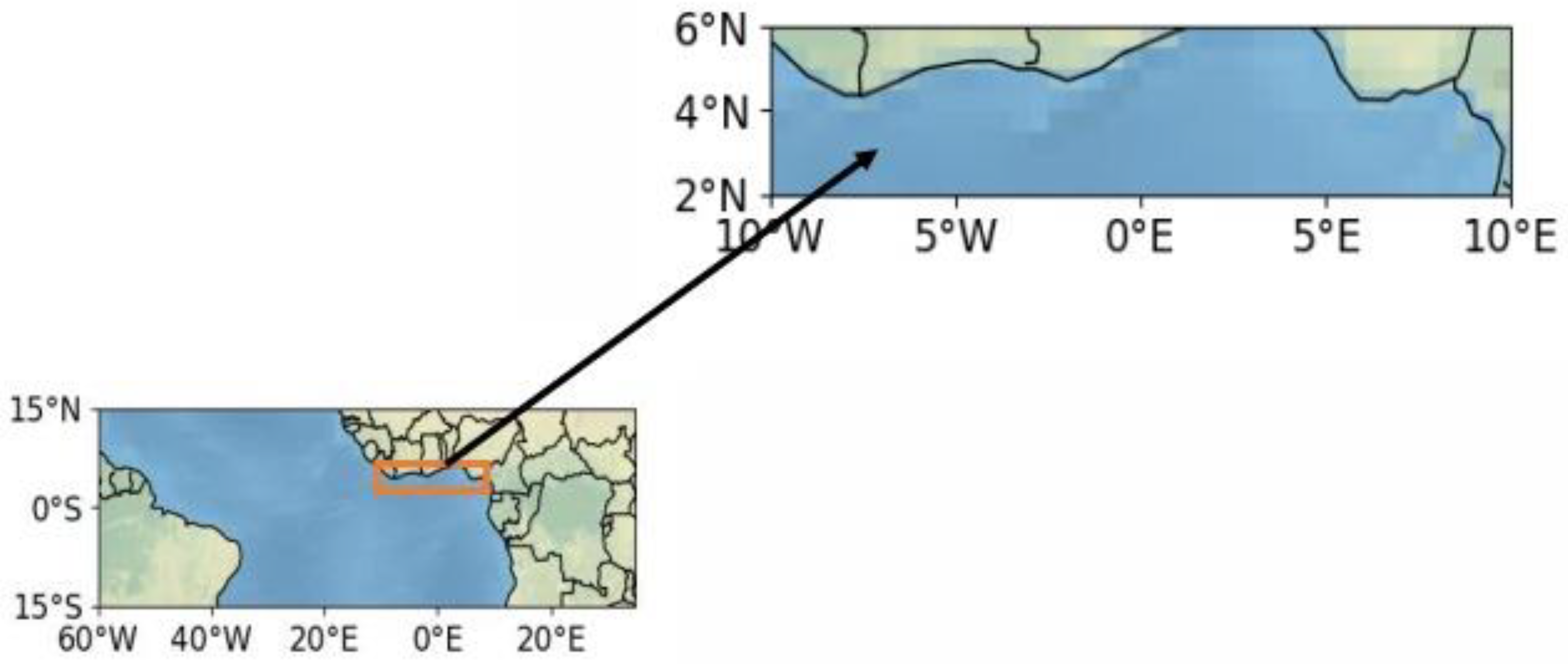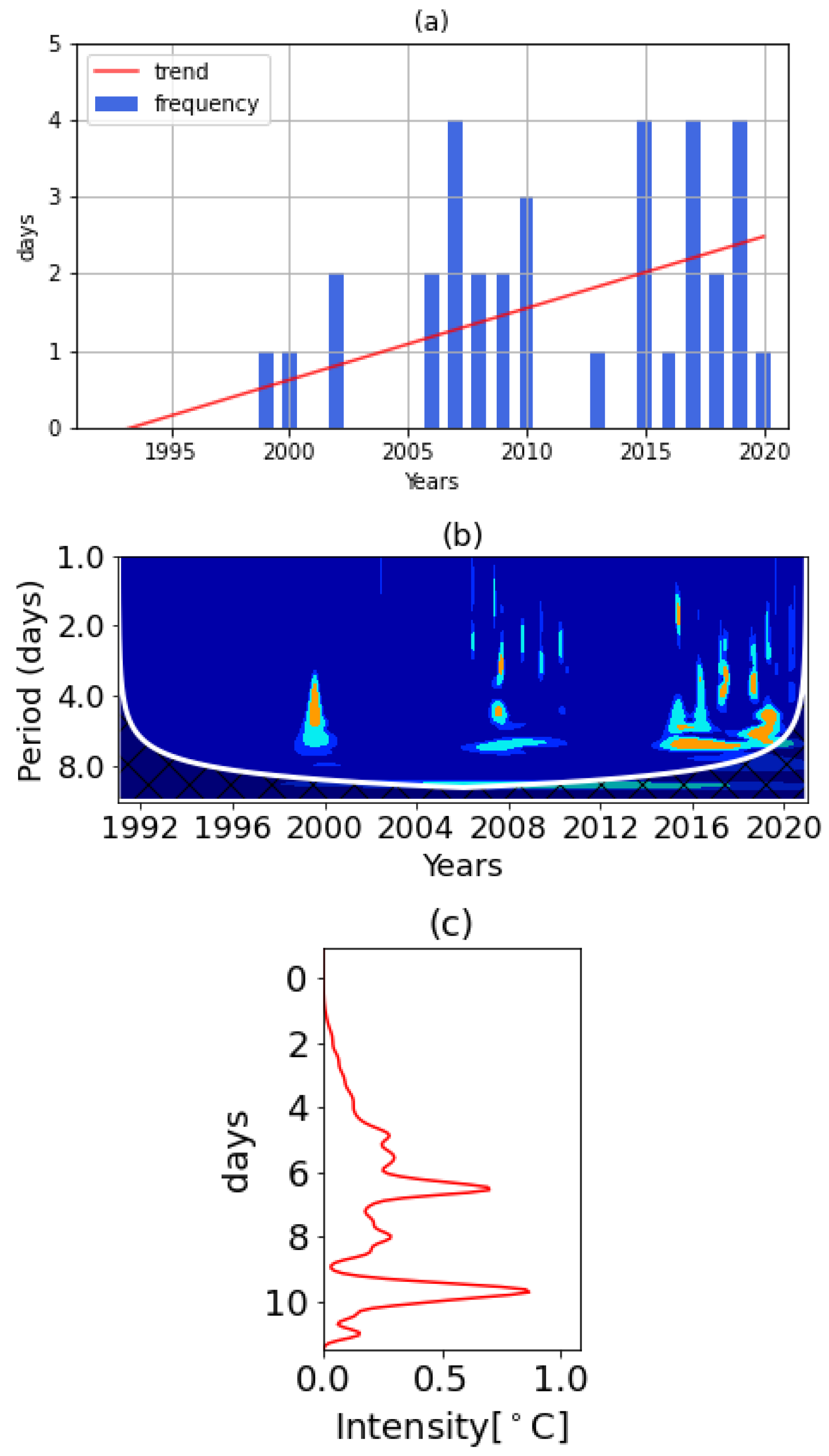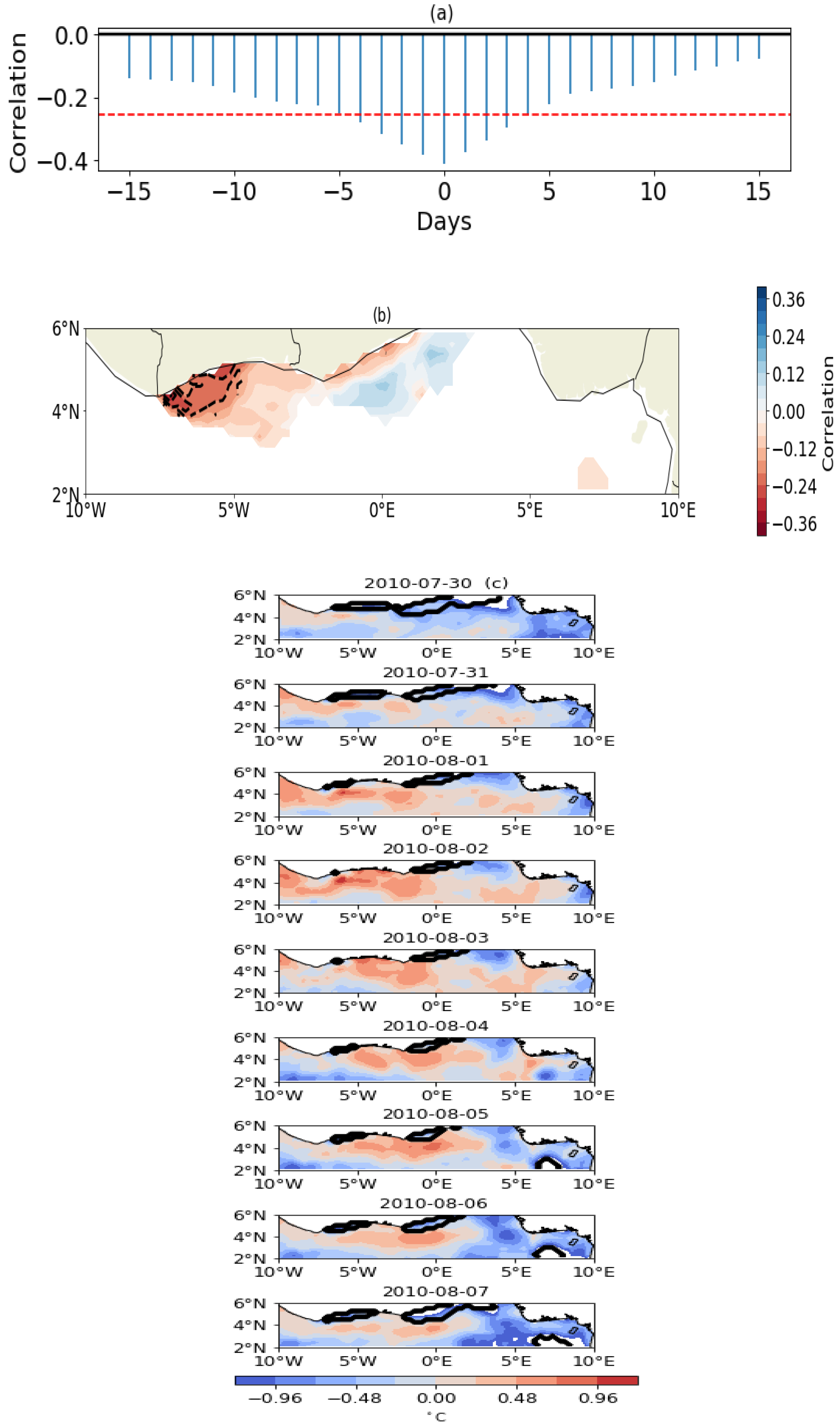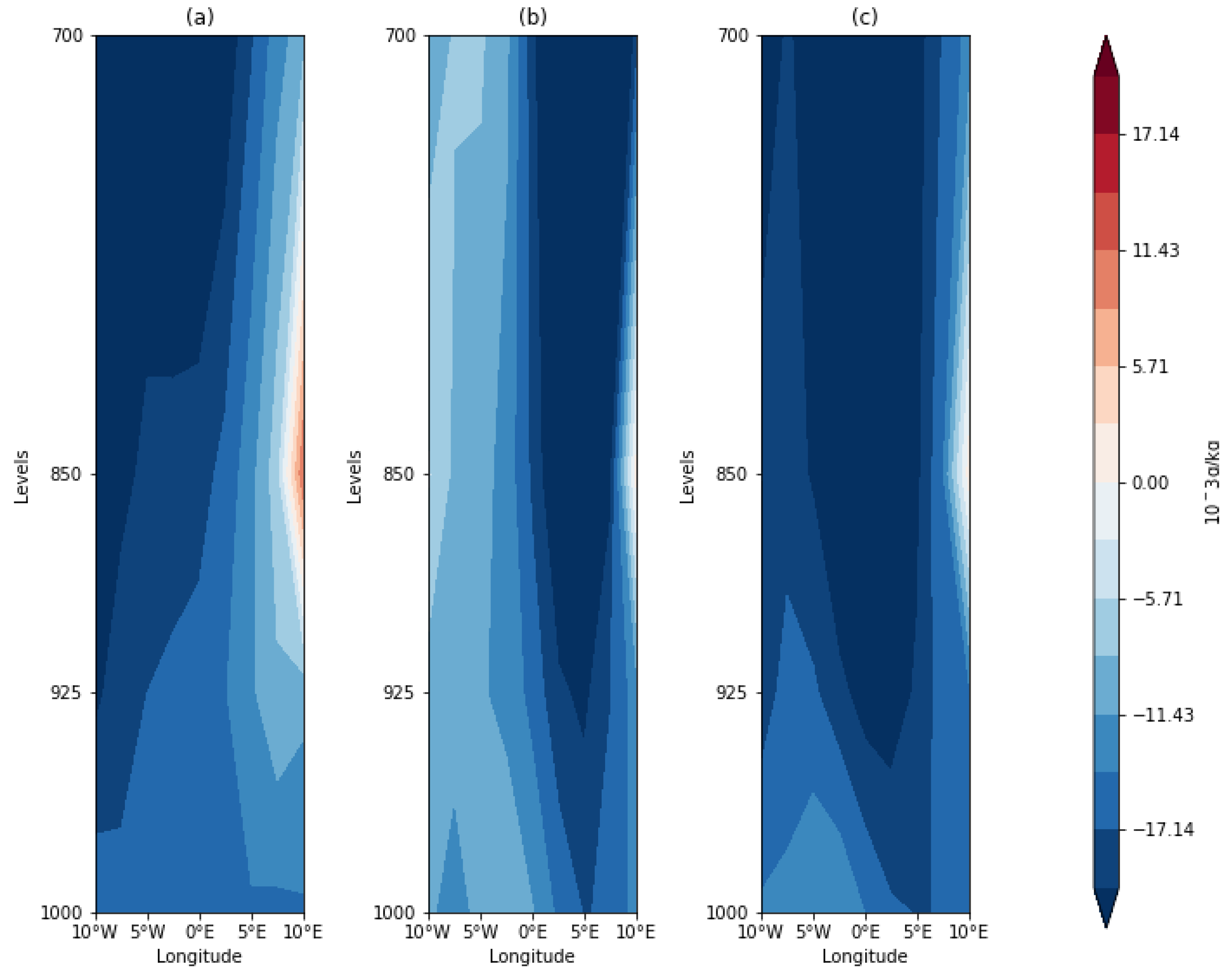Marine Heatwaves, Upwelling, and Atmospheric Conditions during the Monsoon Period at the Northern Coast of the Gulf of Guinea
Abstract
:1. Introduction
2. Data and Methods
2.1. Data
2.2. Detection of Coastal Upwelling Indices and Marine Heatwaves
3. Results
3.1. Upwelling Variability in the Gulf of Guinea
3.2. Trend Analysis and Patterns of MHWs Variability
3.2.1. Temporal Variability of MHWs
3.2.2. Patterns of MHWs Variability
3.2.3. MHWs Trend Analysis
3.3. Overview of the Atmospheric and Ocean Conditions during the MHW Events
3.3.1. Daily Relationship between MHW and Cooling Surface
3.3.2. Ocean Surface and Atmospheric Conditions
4. Discussion and Summary
Author Contributions
Funding
Data Availability Statement
Acknowledgments
Conflicts of Interest
References
- Eltahir, E.A.B.; Gong, C. Dynamics of Wet and Dry Years in West Africa. J. Clim. 1996, 9, 1030–1042. [Google Scholar] [CrossRef]
- Gu, G.; Adler, R.F. Seasonal Evolution and Variability Associated with the West African Monsoon System. J. Clim. 2004, 17, 3364–3377. [Google Scholar] [CrossRef]
- Pauly, D.; Christensen, V. Primary Production Required to Sustain Global Fisheries. Nature 1995, 374, 255–257. [Google Scholar] [CrossRef]
- Kouadio, Y.K.; Ochou, D.A.; Servain, J. Tropical Atlantic and Rainfall Variability in Côte d’Ivoire. Geophys. Res. Lett. 2003, 30, 4. [Google Scholar] [CrossRef]
- Ali, K.E.; Kouadio, K.Y.; Zahiri, E.-P.; Aman, A.; Assamoi, A.P.; Bourles, B. Influence of the Gulf of Guinea Coastal and Equatorial Upwellings on the Precipitations along Its Northern Coasts during the Boreal Summer Period. Asian J. Appl. Sci. 2011, 4, 271–285. [Google Scholar] [CrossRef]
- Morlière, A. Les Saisons Marines Devant Abidjan. In Documents Scientifiques du Centre Recherche Océanographique; CRO: Abidjan, Côte d’Ivoire, 1970; Volume 1. [Google Scholar]
- Colin, C. Coastal upwelling events in front of the Ivory Coast during the FOCAL program. Oceanol. Acta 1988, 11, 125–138. [Google Scholar]
- Kouadio, Y.K.; Djakouré, S.; Aman, A.; Ali, K.E.; Koné, V.; Toualy, E. Characterization of the Boreal Summer Upwelling at the Northern Coast of the Gulf of Guinea Based on the PROPAO In Situ Measurements Network and Satellite Data. Int. J. Oceanogr. 2013, 2013, 1–11. [Google Scholar] [CrossRef] [Green Version]
- IPCC. Global Warming of 1.5 °C: An IPCC special Report on the Impacts of Global Warming of 1.5 °C above Pre-Industrial Levels and Related Global Greenhouse Gas Emission Pathways, in the Context of Strengthening the Global Response to the Threat of Climate Change, Sustainable Development, and Efforts to Eradicate Poverty; Sustainable Development, and Efforts to Eradicate Poverty: Geneva, Switzerland, 2018; p. 538. [Google Scholar]
- Servain, J.; Caniaux, G.; Kouadio, Y.K.; McPhaden, M.J.; Araujo, M. Recent Climatic Trends in the Tropical Atlantic. Clim. Dyn. 2014, 43, 3071–3089. [Google Scholar] [CrossRef]
- Odekunle, T.O.; Eludoyin, A.O. Sea Surface Temperature Patterns in the Gulf of Guinea: Their Implications for the Spatio-Temporal Variability of Precipitation in West Africa. Int. J. Climatol. 2008, 28, 1507–1517. [Google Scholar] [CrossRef]
- Francis, E.A.; Oghenekevwe, C.O. Detection and Spatio-Temporal Variation of Marine Heatwaves in the Gulf of Guinea, Nigeria. J. Oceanogr. Mar. Sci. 2019, 10, 11–21. [Google Scholar] [CrossRef] [Green Version]
- Hobday, A.J.; Alexander, L.V.; Perkins, S.E.; Smale, D.A.; Straub, S.C.; Oliver, E.C.J.; Benthuysen, J.A.; Burrows, M.T.; Donat, M.G.; Feng, M.; et al. A Hierarchical Approach to Defining Marine Heatwaves. Prog. Oceanogr. 2016, 141, 227–238. [Google Scholar] [CrossRef]
- Hobday, A.; Oliver, E.; Sen Gupta, A.; Benthuysen, J.; Burrows, M.; Donat, M.; Holbrook, N.; Moore, P.; Thomsen, M.; Wernberg, T.; et al. Categorizing and Naming Marine Heatwaves. Oceanography 2018, 31, 162–173. [Google Scholar] [CrossRef] [Green Version]
- Lee, S.; Park, M.-S.; Kwon, M.; Kim, Y.H.; Park, Y.-G. Two Major Modes of East Asian Marine Heatwaves. Environ. Res. Lett. 2020, 15, 074008. [Google Scholar] [CrossRef]
- Feng, M.; McPhaden, M.J.; Xie, S.-P.; Hafner, J. La Niña Forces Unprecedented Leeuwin Current Warming in 2011. Sci. Rep. 2013, 3, 1277. [Google Scholar] [CrossRef] [PubMed] [Green Version]
- Pearce, A.F.; Feng, M. The Rise and Fall of the “Marine Heat Wave” off Western Australia during the Summer of 2010/2011. J. Mar. Syst. 2013, 111–112, 139–156. [Google Scholar] [CrossRef]
- Oliver, E.C.J.; Benthuysen, J.A.; Bindoff, N.L.; Hobday, A.J.; Holbrook, N.J.; Mundy, C.N.; Perkins-Kirkpatrick, S.E. The Unprecedented 2015/16 Tasman Sea Marine Heatwave. Nat. Commun. 2017, 8, 16101. [Google Scholar] [CrossRef] [Green Version]
- Sparnocchia, S.; Schiano, M.E.; Picco, P.; Bozzano, R.; Cappelletti, A. The Anomalous Warming of Summer 2003 in the Surface Layer of the Central Ligurian Sea (Western Mediterranean). Ann. Geophys. 2006, 24, 443–452. [Google Scholar] [CrossRef]
- Olita, A.; Sorgente, R.; Natale, S.; Gaberšek, S.; Ribotti, A.; Bonanno, A.; Patti, B. Effects of the 2003 European Heatwave on the Central Mediterranean Sea: Surface Fluxes and the Dynamical Response. Ocean Sci. 2007, 3, 273–289. [Google Scholar] [CrossRef] [Green Version]
- Caputi, N.; Kangas, M.; Denham, A.; Feng, M.; Pearce, A.; Hetzel, Y.; Chandrapavan, A. Management Adaptation of Invertebrate Fisheries to an Extreme Marine Heat Wave Event at a Global Warming Hot Spot. Ecol. Evol. 2016, 6, 3583–3593. [Google Scholar] [CrossRef]
- Walsh, J.E.; Thoman, R.L.; Bhatt, U.S.; Bieniek, P.A.; Brettschneider, B.; Brubaker, M.; Danielson, S.; Lader, R.; Fetterer, F.; Holderied, K.; et al. The High Latitude Marine Heat Wave of 2016 and Its Impacts on Alaska. Bull. Am. Meteorol. Soc. 2018, 99, S39–S43. [Google Scholar] [CrossRef]
- Acheampong, E.; Mantey, P.; Weremfo, A. Potential Impact of Marine Heatwaves on Selected Phytoplankton Adapted to the Gulf of Guinea during Stable Hydrographic Periods. Afr. J. Mar. Sci. 2021, 43, 77–86. [Google Scholar] [CrossRef]
- Binet, D. Influence des variations climatiques sur la pêcherie des Sardinella aurita ivoiro-ghanéenne: Relation sécheresse-surpêche. Oceanol. Acta 1982, 5, 443–452. [Google Scholar]
- Djakouré, S.; Penven, P.; Bourlès, B.; Veitch, J.; Koné, V. Coastally Trapped Eddies in the North of the Gulf of Guinea. J. Geophys. Res. Oceans 2014, 119, 6805–6819. [Google Scholar] [CrossRef]
- Djakouré, S.; Penven, P.; Bourlès, B.; Koné, V.; Veitch, J. Respective Roles of the Guinea Current and Local Winds on the Coastal Upwelling in the Northern Gulf of Guinea. J. Phys. Oceanogr. 2017, 47, 1367–1387. [Google Scholar] [CrossRef]
- Ta, S.; Kouadio, K.Y.; Ali, K.E.; Toualy, E.; Aman, A.; Yoroba, F. West Africa Extreme Rainfall Events and Large-Scale Ocean Surface and Atmospheric Conditions in the Tropical Atlantic. Adv. Meteorol. 2016, 2016, 1940456. [Google Scholar] [CrossRef] [Green Version]
- Reynolds, R.W.; Rayner, N.A.; Smith, T.M.; Stokes, D.C.; Wang, W. An Improved In Situ and Satellite SST Analysis for Climate. J. Clim. 2002, 15, 1609–1625. [Google Scholar] [CrossRef]
- Kalnay, E.; Kanamitsu, M.; Kistler, R.; Collins, W.; Deaven, D.; Gandin, L.; Iredell, M.; Saha, S.; White, G.; Woollen, J.; et al. The NCEP/NCAR 40-Year Reanalysis Project. Bull. Am. Meteorol. Soc. 1996, 77, 437–471. [Google Scholar] [CrossRef]
- Caniaux, G.; Giordani, H.; Redelsperger, J.-L.; Guichard, F.; Key, E.; Wade, M. Coupling between the Atlantic Cold Tongue and the West African Monsoon in Boreal Spring and Summer. J. Geophys. Res. 2011, 116, C04003. [Google Scholar] [CrossRef]
- Bakun, A. Guinea Current Upwelling. Nature 1978, 271, 147–150. [Google Scholar] [CrossRef]
- Oliver, E.C.J.; Donat, M.G.; Burrows, M.T.; Moore, P.J.; Smale, D.A.; Alexander, L.V.; Benthuysen, J.A.; Feng, M.; Sen Gupta, A.; Hobday, A.J.; et al. Longer and More Frequent Marine Heatwaves over the Past Century. Nat. Commun. 2018, 9, 1324. [Google Scholar] [CrossRef] [Green Version]
- North, G.R.; Bell, T.L.; Cahalan, R.F.; Moeng, F.J. Sampling Errors in the Estimation of Empirical Orthogonal Functions. Mon. Weather Rev. 1982, 110, 699–706. [Google Scholar] [CrossRef]
- Servain, J.; Legler, D.M. Empirical Orthogonal Function Analyses of Tropical Atlantic Sea Surface Temperature and Wind Stress: 1964–1979. J. Geophys. Res. 1986, 91, 14181. [Google Scholar] [CrossRef]
- Da-Allada, C.Y.; Agada, J.; Baloïtcha, E.; Hounkonnou, M.N.; Jouanno, J.; Alory, G. Causes of the Northern Gulf of Guinea Cold Event in 2012. J. Geophys. Res. Oceans 2021, 126, e2021JC017627. [Google Scholar] [CrossRef]
- Liebmann, B.; Dole, R.M.; Jones, C.; Bladé, I.; Allured, D. Influence of Choice of Time Period on Global Surface Temperature Trend Estimates. Bull. Am. Meteorol. Soc. 2010, 91, 1485–1492. [Google Scholar] [CrossRef]
- Carton, J.A.; Huang, B. Warm Events in the Tropical Atlantic. J. Phys. Oceanogr. 1994, 24, 888–903. [Google Scholar] [CrossRef]
- Yang, Y.; Wu, L.; Guo, Y.; Gan, B.; Cai, W.; Huang, G.; Li, X.; Geng, T.; Jing, Z.; Li, S.; et al. Greenhouse Warming Intensifies North Tropical Atlantic Climate Variability. Sci. Adv. 2021, 7, eabg9690. [Google Scholar] [CrossRef] [PubMed]
- Illig, S. Variabilité Basse Fréquence de l’Atlantique Tropical: Rôle de la Dynamique Océanique Équatoriale et Influence d’El Niño Southern Oscillation. Ph.D. Thesis, Université Paul Sabatier—Toulouse III, Toulouse, France, 2005. [Google Scholar]
- Zebiak, S.E. Air–Sea Interaction in the Equatorial Atlantic Region. J. Clim. 1993, 6, 1567–1586. [Google Scholar] [CrossRef]
- Liu, W.; Xie, S.-P.; Lu, J. Tracking Ocean Heat Uptake during the Surface Warming Hiatus. Nat. Commun. 2016, 7, 10926. [Google Scholar] [CrossRef]












Publisher’s Note: MDPI stays neutral with regard to jurisdictional claims in published maps and institutional affiliations. |
© 2022 by the authors. Licensee MDPI, Basel, Switzerland. This article is an open access article distributed under the terms and conditions of the Creative Commons Attribution (CC BY) license (https://creativecommons.org/licenses/by/4.0/).
Share and Cite
Koné, M.; Djakouré, S.; Adon, M.; Ta, S.; Kouadio, Y. Marine Heatwaves, Upwelling, and Atmospheric Conditions during the Monsoon Period at the Northern Coast of the Gulf of Guinea. Climate 2022, 10, 199. https://doi.org/10.3390/cli10120199
Koné M, Djakouré S, Adon M, Ta S, Kouadio Y. Marine Heatwaves, Upwelling, and Atmospheric Conditions during the Monsoon Period at the Northern Coast of the Gulf of Guinea. Climate. 2022; 10(12):199. https://doi.org/10.3390/cli10120199
Chicago/Turabian StyleKoné, Mamadou, Sandrine Djakouré, Marcellin Adon, Samuel Ta, and Yves Kouadio. 2022. "Marine Heatwaves, Upwelling, and Atmospheric Conditions during the Monsoon Period at the Northern Coast of the Gulf of Guinea" Climate 10, no. 12: 199. https://doi.org/10.3390/cli10120199
APA StyleKoné, M., Djakouré, S., Adon, M., Ta, S., & Kouadio, Y. (2022). Marine Heatwaves, Upwelling, and Atmospheric Conditions during the Monsoon Period at the Northern Coast of the Gulf of Guinea. Climate, 10(12), 199. https://doi.org/10.3390/cli10120199





